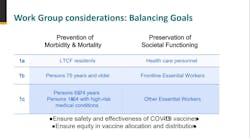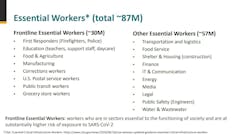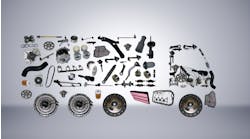Transportation workers now in third group of COVID-19 vaccine deployment
In December 2020, the Advisory Committee on Immunization Practices (ACIP) expanded its recommendation regarding who will be the first to receive the novel coronavirus vaccine as well as who will subsequently receive it following Phase 1a.
In its initial recommendation made on Dec. 1, the committee agreed that health care personnel and residents of long-term care facilities should be the first to receive the vaccine in its Phase 1a deployment – with essential workers, such as those in the transportation industry, to be the whole of the Phase 1b launch. However, transportation workers have now been moved to "other essential workers" to receive the vaccine in Phase 1c.
While the recommendations are not binding, they have – in the past – determined the scope and funding of U.S. vaccination programs, according to the Associated Press.
ACIP chairman Jose Romero advised vaccine deployment will be up to state authorities if they choose to follow the federal guidelines.
The only member of the committee to oppose the recommendation was Helen Talbot, an infectious disease specialist at Vanderbilt University, who expressed her lack of confidence before the vote with putting long-term care facility residents in the Phase 1a group because the vaccines hadn’t been studied in that particular population.
“We enter this realm of, ‘We hope it works and we hope it’s safe,’ and that concerns me on many levels,” Talbot said.
Phase 1b and 1c
On Dec. 1, the American Trucking Associations (ATA) submitted letters to the White House, the ACIP, President-elect Joe Biden and the National Governors Association urging them to remember the trucking industry’s essential status as a national vaccine distribution strategy is being formulated by officials across various levels of government.
ATA asked that the trucking industry’s workforce be included in prioritized access pools along with other essential workers – which are the whole of the ACIP’s Phase 1b interim recommendation. However, the CDC has decided to split the essential workers category under these industries:
In August 2020, the Cyber Security & Infrastructure Security Agency updated its Essential Critical Infrastructure Workers Guide Version 4.0, which provides guidance on how jurisdictions and critical infrastructure owners can prioritize the ability of essential workers to work safely while supporting ongoing infrastructure operations across the nation.
Version 4.0, which defines 16 critical infrastructure sectors, identifies those essential workers that require specialized risk management strategies to ensure that they can work safely. It can also be used to begin planning and preparing for the allocation of scarce resources used to protect essential workers against COVID-19.
“Our nation’s ability to successfully confront the COVID-19 pandemic depends on the resilience and integrity of our transportation networks,” wrote Bill Sullivan, ATA’s executive vice president of advisory in the letters. “The trucking industry is proud to play an outsized role in COVID-19 response and recovery efforts, and we ask that you consider the essential nature of the trucking workforce as you implement plans for vaccine distribution. As we saw at the outset of the pandemic, when supply lines are disrupted, consequences are fast to follow.”
The United States Department of Transportation has continued its support by establishing a nationwide exemption to hours-of-service regulations for trucking companies and commercial drivers providing direct emergency assistance. The Federal Motor Carrier Safety Administration’s long-standing Emergency Declaration was also extended on Dec. 1 to support emergency transportation of vaccines, medical supplies, and equipment related to the prevention of COVID-19.
After the ACIP gave its initial recommendation on Dec. 1, members of the committee were given time to speak as to the reason behind their vote.
“I voted in the affirmative because of this committee’s goal – to maximize benefits and minimize harm while promoting justice and addressing health inequities,” said Romero.
Beth Bell, co-chair of the ACIP, made note on behalf of the panel that all of the members would have liked more data from the clinical trials but said that, because of the pandemic emergency, “we need to act.”






